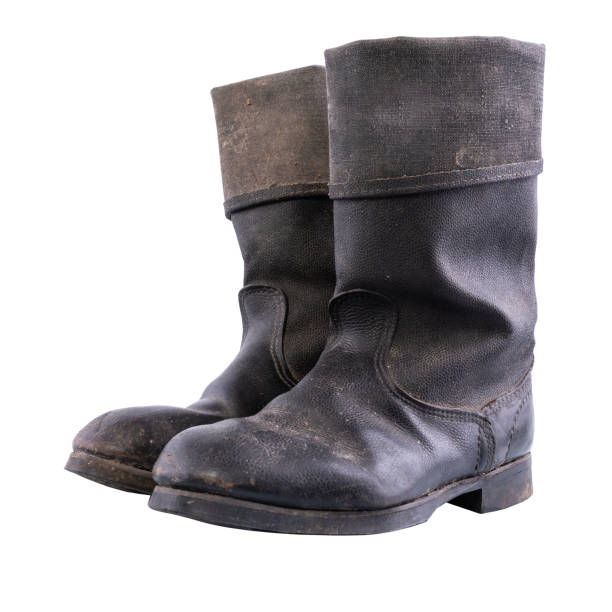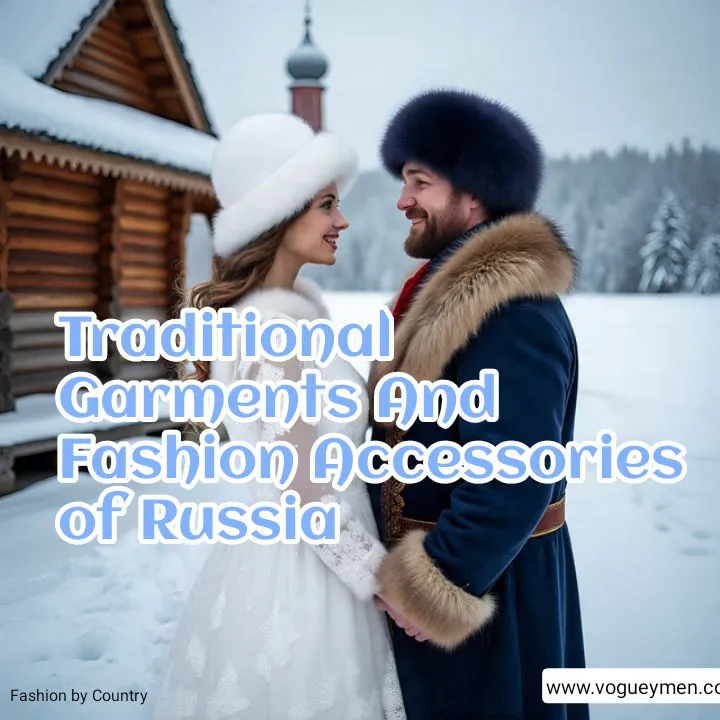Fashion in Russia is as ancient, majestic, and awe-inspiring as the country itself. The world’s largest nation, spanning 11 time zones, Russia is the land of czars and the birthplace of Yuri Gagarin, the first human in space—hardly a dull backdrop for fashion. Given its cold and vast geography, traditional Russian style (Traditional Garments and Fashion Accessories of Russia) relies on warm materials like wool, fur, and felt to keep garments winter-appropriate. Russian fashion is much more than the iconic sable fur coats, fur-lined ushanka hats, and regal kokoshniks. These symbols of Russian elegance are only part of a broader legacy of garments, textiles, and craftsmanship that reflect the nation’s rich past and vibrant culture. It is this blend of history, artistry, and practicality that makes Russian fashion unique, exciting, and endlessly fascinating. Let’s dive deeper into Russia’s fashion profile in some detail.
Russia’s iconic folk garments for men and women
Let us begin with Russia’s iconic folk garments—the timeless silhouettes that rise from the nation’s vast steppes and storied past. More than clothing, they are living emblems of heritage and artistry, garments that carry the rhythm of Russian culture in every fold and thread.
Sarafan
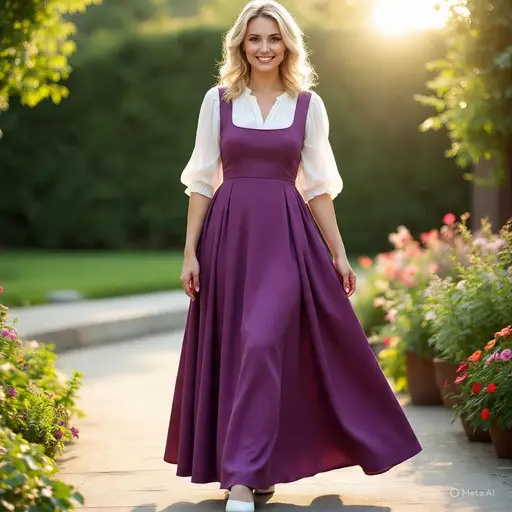
The sarafan is a traditional Russian sleeveless dress for women, typically worn over a blouse. Flowing from shoulder to ankle, it is crafted from cotton, silk, or brocade, depending on status and occasion. Peasant women favored simpler fabrics, while noblewomen wore richly embroidered or patterned versions. Originating in the 14th century, it became one of Russia’s most iconic garments, symbolizing modesty and national identity. Today, the sarafan is mainly seen in folk festivals, stage performances, and cultural showcases, embodying timeless femininity.
Rubakha (Russian Peasant Shirt)
The rubakha is a versatile tunic-style shirt, worn by both men and women in old Russia. Made of linen, hemp, or cotton, it was an everyday essential. Peasants wore it plain as both underwear and outerwear, while wealthier families decorated festive rubakhas with embroidery at the neck, cuffs, and hem. Its simple, straight-cut style made it practical for labor and easy to produce. Deeply rooted in Slavic tradition, the rubakha reflects a way of life centered on utility, modesty, and symbolic ornamentation.
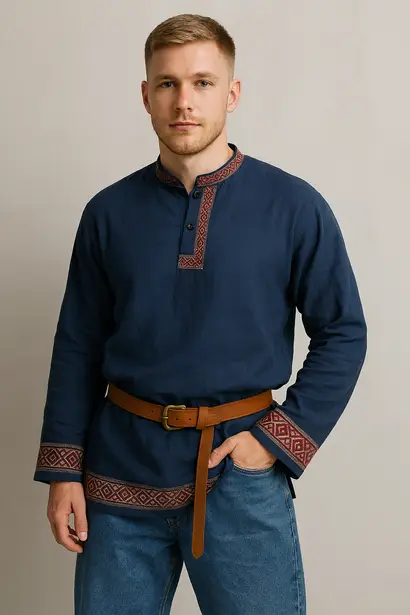
Kosovorotka (Russian Silk Shirt)
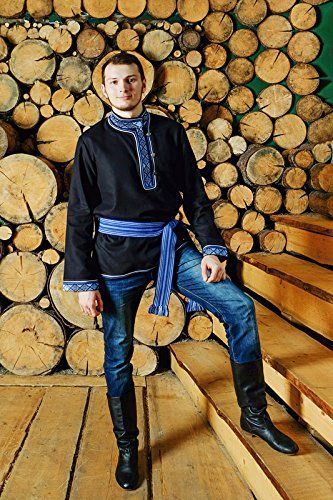
The kosovorotka is a men’s folk shirt distinguished by its asymmetrical collar, fastening near the shoulder. Traditionally made of linen or cotton, festive versions were embroidered or occasionally made of silk. Its side-buttoning design was practical, leaving space for an Orthodox cross worn underneath without interfering. Popular from the 19th century among peasants and intellectuals alike, it became a symbol of Russian identity, often paired with a belt and trousers. Today, it survives as a ceremonial or cultural garment worn in performances and heritage events. image source
Telnyashka
The telnyashka is a striped undershirt that originated with the Russian navy and later became standard for airborne forces and elite troops. Recognizable by its crisp horizontal blue-and-white stripes, it is often compared to the French Breton top—yet while the Breton evolved into a symbol of artistic elegance and Parisian chic, the telnyashka carries an unmistakable air of toughness, discipline, and patriotism. Traditionally made of soft, knitted cotton, it comes in sleeveless, short-sleeved, and long-sleeved versions. In fashion, it has transcended its military roots, styled with jeans, leather jackets, or under blazers, offering a minimalist but bold look that remains distinctly Russian.
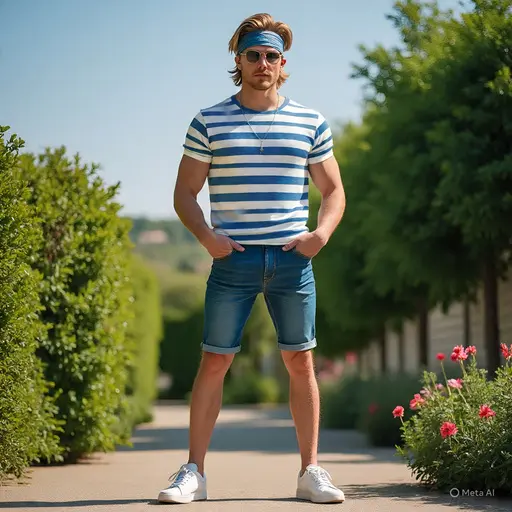
Telnyashka has a striking similarity with the French Breton Top, You can explore more about French fashion accessories and garments here.
Shuba
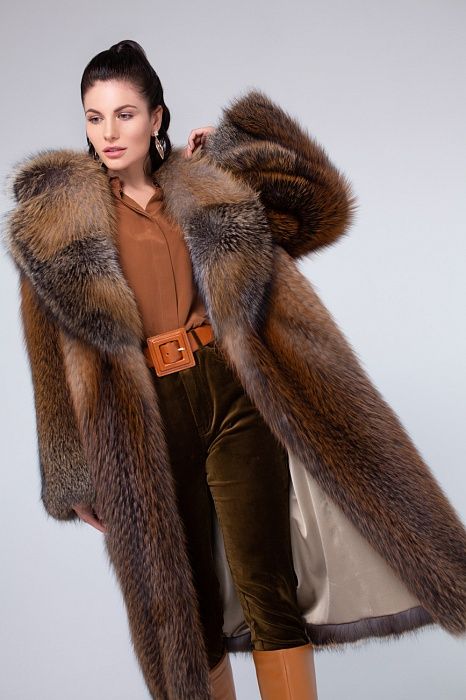
A shuba is Russia’s iconic full-length fur coat, designed for both men and women to withstand frigid winters. Traditionally crafted from sheepskin, sable, or fox, it balanced practicality with prestige. For peasants, the shuba was everyday armor against Siberian cold, while for nobility it became a status symbol, often richly trimmed. Its voluminous silhouette allowed for layering underneath, making it indispensable in pre-modern Russia. Today, shubas remain a luxurious fashion item, blending centuries-old craftsmanship with contemporary winter style, prized for warmth and cultural legacy. Image Source
Telogreika / Fufaika / Vatnik Jacket
The telogreika, also called fufaika or vatnik, is a padded quilted jacket originally made of cotton fabric stuffed with wool or cotton batting. Unisex in use, it became standard Soviet military and worker wear during the 20th century for its warmth and durability in harsh conditions. Its simple, utilitarian cut symbolized collective resilience and modest practicality. Though once humble, the vatnik has gained nostalgic and cultural significance, inspiring modern streetwear and fashion collections. Today, it embodies a gritty yet iconic Soviet contribution to outerwear. Image Source
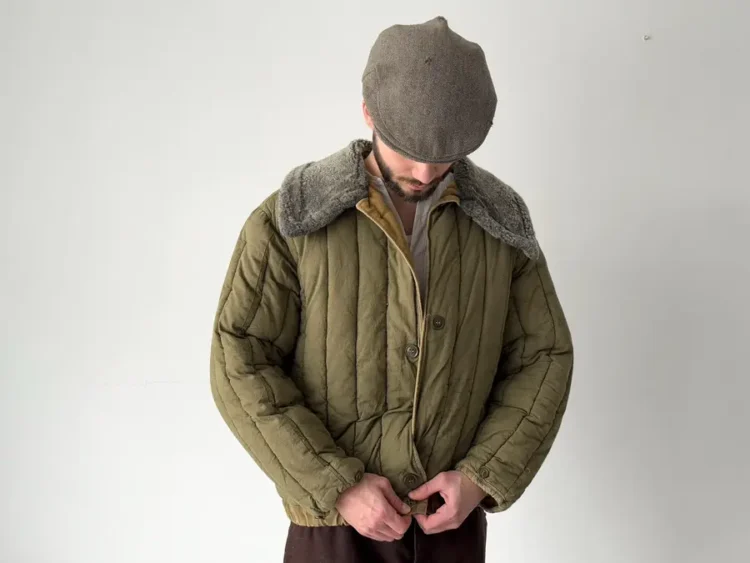
Khokhloma Print Dress
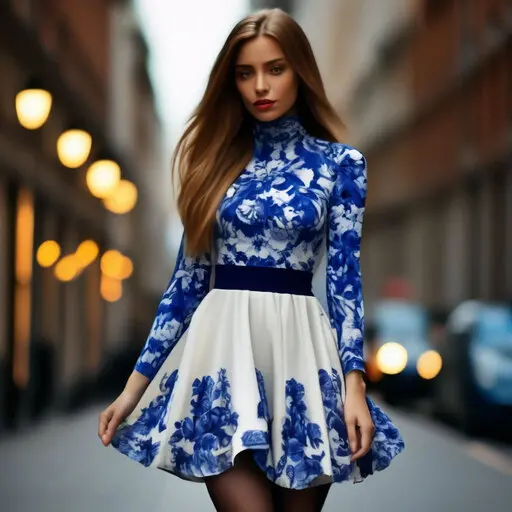
Khokhloma print dresses draw on Russia’s folk painting tradition, featuring ornate gold and red floral motifs on black backgrounds. Typically made of cotton or polyester blends, these dresses are designed for women but have also inspired unisex festival garments. Rooted in 17th-century wooden tableware decoration, Khokhloma artistry migrated to textiles in the 20th century, blending heritage with contemporary style. These dresses are particularly popular at folk festivals, cultural shows, and souvenir markets, offering a vibrant celebration of Russian artistry and national symbolism through wearable design. Image Source
The Bekesha jacket
The Bekesha jacket is a traditional Russian winter coat, originally worn by military officers in the 19th and early 20th centuries. Crafted from heavy wool or sheepskin and lined with fur—often sheared lamb or fox—it was designed to withstand brutal cold. Its long, belted silhouette and wide fur collar offered both warmth and authority. Though historically masculine, modern interpretations of the Bekesha are unisex, blending heritage with contemporary tailoring. The coat’s utilitarian roots trace back to Imperial Russia and later Soviet uniforms, making it a symbol of resilience and rugged style. Today, it’s a vintage icon with timeless appeal.
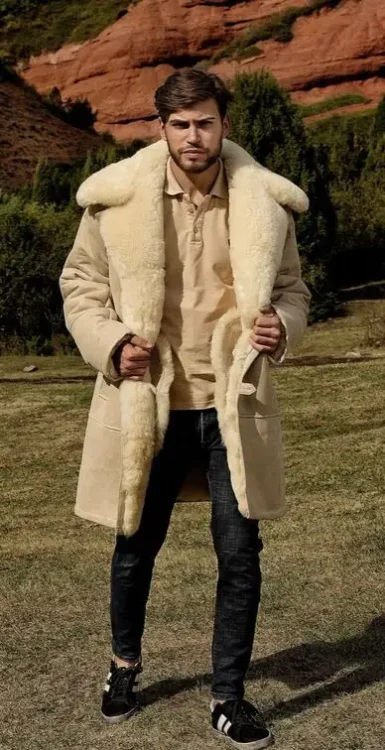
Malitsa and Sudarushka
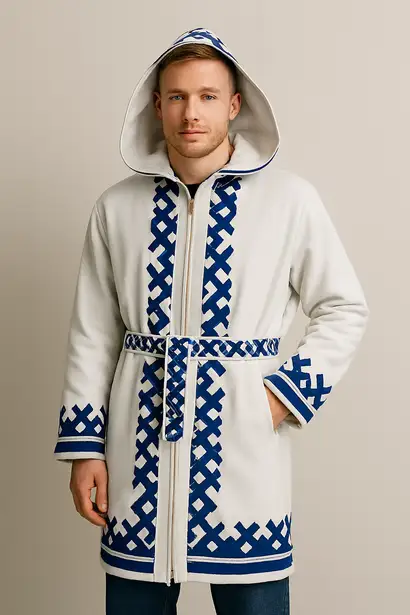
The malitsa is a traditional unisex reindeer-hide coat worn by the Nenets of Siberia. With fur turned inward, an integrated hood, and attached mittens, it functioned as a personal shelter in Arctic conditions. The women’s version, called the sudarushka, featured a front opening tied with straps, making it practical for nomadic life and childcare. Both garments reflect indigenous ingenuity in battling extreme cold, blending functionality and spiritual symbolism. Today, malitsas and sudarushkas are cultural treasures, often showcased in ethnographic museums and Arctic heritage festivals.
Matryoshka Doll Print Dresses and Shirts
Matryoshka print garments bring playful folk art into modern fashion. Found on cotton or polyester fabric, these dresses and shirts feature colorful nesting-doll motifs, celebrating Russia’s most famous craft symbol. Designed for both men and women, though most popular in women’s fashion, they merge tradition with everyday wearability. Emerging in the late 20th century as souvenir and themed clothing, they appeal to both locals and tourists. Today, these garments serve as cheerful, wearable emblems of Russian identity, blending cultural nostalgia with pop-inspired modern style.
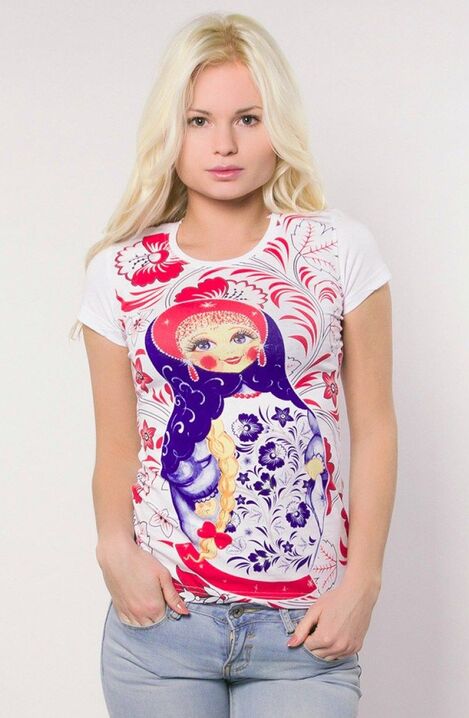
Russia’s very own fashion accessories, and jewelry
Russian fashion accessories are more than functional—they’re cultural storytellers. From the iconic earflapped ushanka and bold Kartuz cap to the delicate artistry of the Orenburg shawl, each piece blends tradition, warmth, and elegance. And that’s just the beginning—there’s a whole world of accessories waiting to be uncovered.
Ushanka
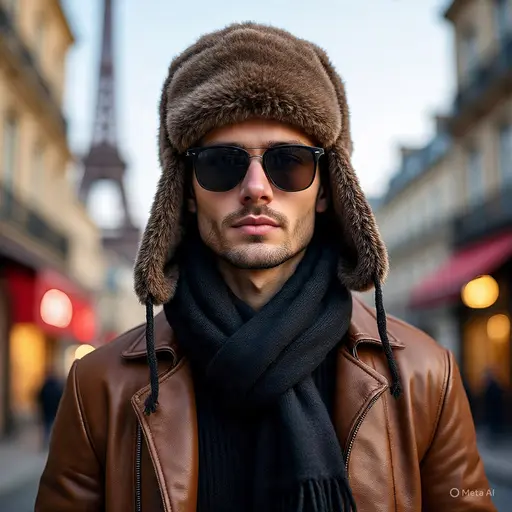
The ushanka is perhaps the most recognizable Russian winter hat, instantly evoking images of snowy streets and icy winds. Its distinctive ear flaps, known as ushí (ears), can be tied up on top for a tidy look or pulled down and fastened under the chin for full warmth. Traditionally crafted from fur, sheepskin, or later faux fur, the ushanka became standard issue for Soviet soldiers and beloved by civilians alike. Today it remains both a practical shield against subzero winters and an enduring cultural icon.
Kartuz Cap
The kartuz cap is a distinctly Russian headpiece that blends military sharpness with civilian flair. Shaped with a flat, wide crown and a firm peak at the front, it resembles a stiffened sailor’s cap but often features decorative cords, buttons, or embroidery. Traditionally made from wool, felt, or sturdy cloth, it provided warmth while holding its structured silhouette. In the 19th and early 20th centuries, it was worn by students, workers, and officers alike—symbolizing intellect, discipline, and style. Today, it survives in folk costumes and nostalgic fashion revivals. Image Source
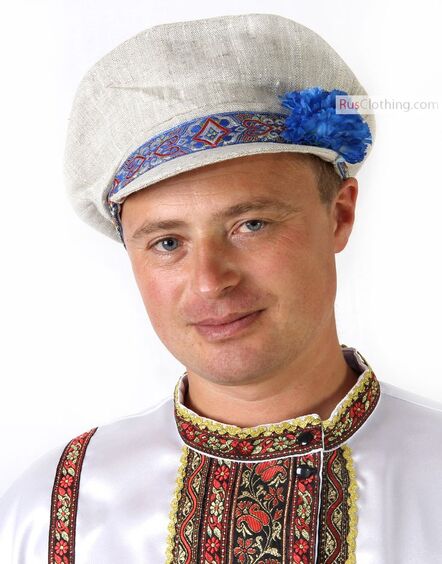
Kokoshnik
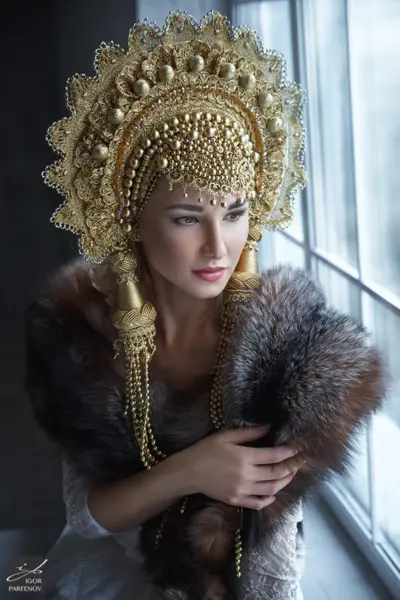
The kokoshnik is a breathtakingly ornate headdress, crescent or halo-shaped, that crowned Russian women’s attire from the 16th through the 19th centuries. Worn especially by brides and at festive occasions, it shimmered with pearls, sequins, beads, and threads of gold or silver embroidery. Its shape varied by region—from tall and pointed to wide and rounded—always designed to frame the face like a halo of elegance. While no longer everyday wear, the kokoshnik endures as a dazzling emblem of Russian femininity, heritage, and national artistry.
Orenburg Shawl
The Orenburg shawl, also called the “wedding ring shawl,” is a marvel of Russian textile artistry. Hand-knitted from the gossamer-soft down of Orenburg goats, its lace patterns are so fine that a full shawl can be pulled through a ring, yet it remains astonishingly warm. Each piece takes months of patient work, blending practicality with delicate beauty. Cherished as heirlooms, these shawls are worn on frosty days, gifted at weddings, and treasured as symbols of elegance, endurance, and world-class Russian craftsmanship. Image Source
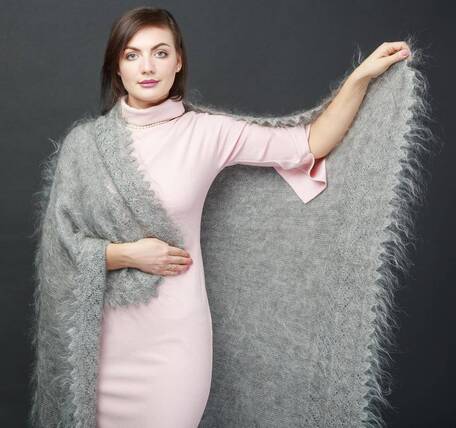
Pavlovo Posad Shawl
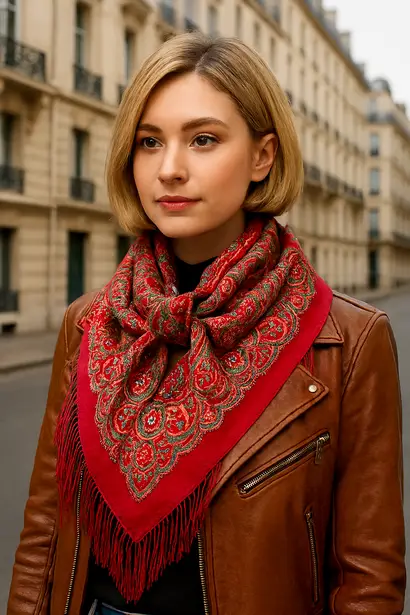
The Pavlovo Posad shawl is a richly patterned woolen scarf produced in a historic town near Moscow. Known for vivid floral and paisley designs, it often features bold, contrasting colors and a decorative fringe. These shawls serve both aesthetic and practical purposes: keeping the wearer warm while adding an artistic flair. Worn draped over the shoulders, as a headscarf, or tied fashionably at the neck, they remain an enduring symbol of Russian folk artistry cherished by women across generations.
Papakha
The papakha is a tall, cylindrical fur hat associated with Cossacks and Caucasian mountaineers. Made of sheepskin or karakul wool, it retains heat in cold highland climates while also signaling status and masculinity. Historically adopted into Russian and Soviet military uniforms, it became emblematic of honor and strength. Today, the papakha is still worn during ceremonial events, national dances, and cultural festivals, where it stands as both a functional piece of winter wear and a proud regional identity marker.
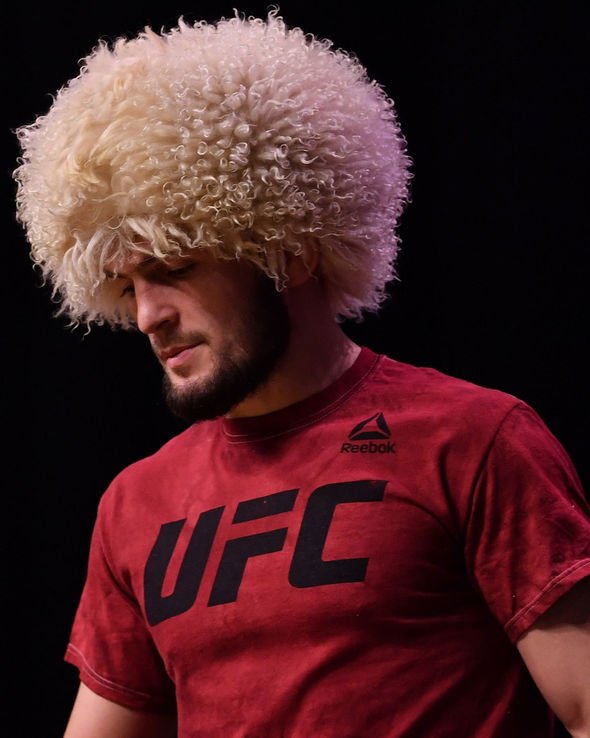
Budenovka (Frunzenka Hat)
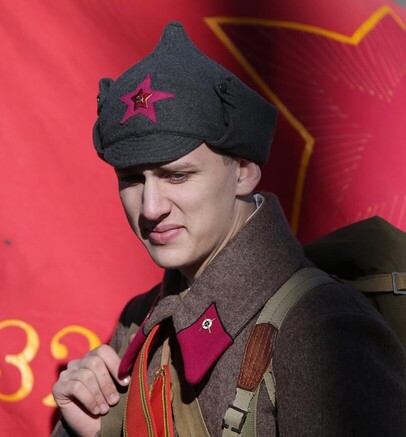
The budenovka is a pointed wool hat introduced during the Russian Civil War, initially designed for the Red Army. Its distinctive elongated tip often folded to one side, resembling a medieval helmet, gave soldiers both protection from cold and a strong ideological symbol. Usually made from thick felted wool, sometimes with a red star badge, it was more emblematic than practical. Though discontinued as military gear, the budenovka survives as a cultural icon tied to early Soviet identity. image source
Kubanka Hat or Cossack fur hat
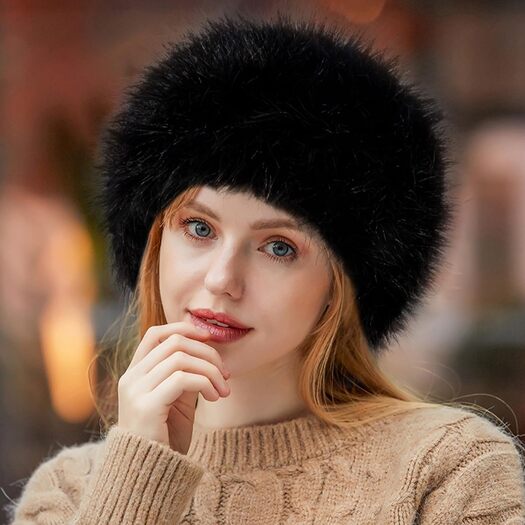
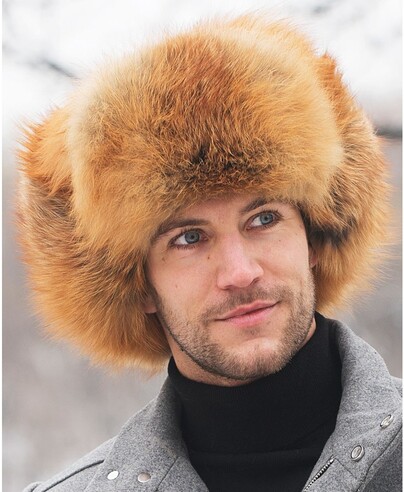
The Kubanka is a classic Russian fur hat known for its short, cylindrical shape and flat crown—often resembling a plush drum. Made from Astrakhan karakul or sheepskin, it wraps dense, curly fur around a structured wool or felt base. Originating in the Kuban and Don Cossack regions, the Kubanka symbolizes military pride and ethnic identity. Often referred to as the Cossack fur hat, it’s essentially a flapless ushanka—retaining warmth and texture while offering a cleaner, more formal silhouette. Popular in Soviet ceremonial uniforms, the Kubanka blends elegance with martial tradition, making it a timeless icon of Russian fashion.
Platok or Babushka Headscarf
The platok, often affectionately called a babushka scarf, is a square headscarf worn folded into a triangle and tied under the chin. Traditionally made of cotton, silk, or wool, it serves both modesty and protection against wind and cold. Popular among peasant women and grandmothers, it became one of the most recognizable accessories of Russian village life. Beyond practicality, floral and folk-inspired patterns turned the platok into a symbol of femininity and resilience, now often revived in nostalgic fashion. Image Source
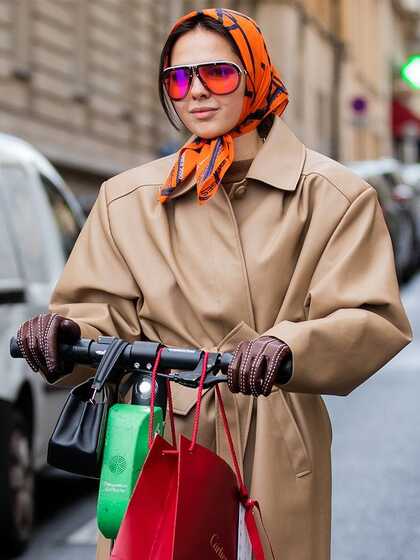
The Banya hat

The Banya is a distinctive Russian wool cap traditionally worn inside steam baths, known as banyas. Made from thick felted sheep’s wool, it resembles a pointed beanie or bell-shaped cap, designed to protect the head from extreme heat during sauna sessions. The dense wool insulates against sudden temperature changes, preventing dizziness or overheating. Often plain, but sometimes embroidered or cut with playful folk motifs, the banya hat blends practicality with cultural charm, embodying Russia’s unique approach to wellness and warmth.
Finift Jewelry
Finift jewelry refers to enamel-painted ornaments crafted in Rostov Veliky, a Russian town famed for this art since the 17th century. Typically, a thin copper or silver plate is hand-painted with miniature floral or religious motifs, then enamel-fired for durability. These vibrant pieces—pendants, crosses, earrings, and rings—combine folk artistry with fine craftsmanship. Worn for both adornment and as tokens of faith, finift jewelry remains a unique expression of Russian decorative tradition, treasured as both heritage keepsake and artistic accessory.
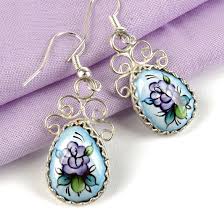
Russian traditional footwear:
In this section we’ll discuss traditional Russian footwear.
Valenki
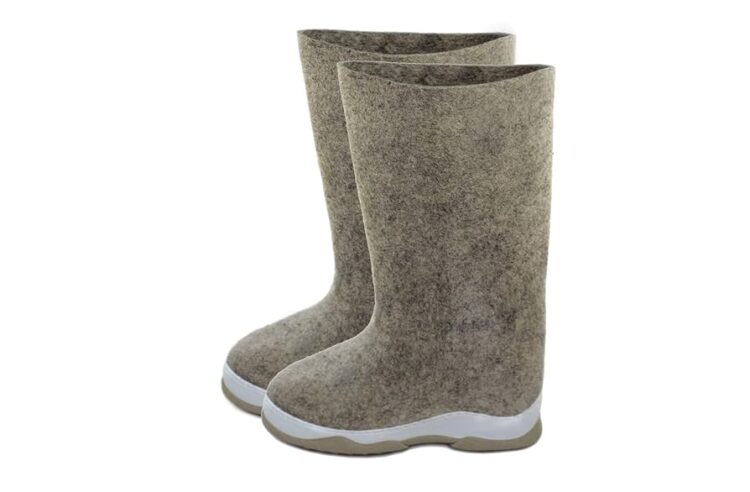
Valenki are the quintessential Russian winter boots, crafted from thickly felted wool to withstand the bitterest cold. Seamless and cushiony, they feel soft yet insulate like no other footwear. Traditionally worn in villages, valenki were paired with rubber galoshes to protect against snow and slush. For centuries, they symbolized practicality and survival in subzero winters. Today, designers have revived them with colorful trims, modern soles, and playful embellishments—transforming a humble peasant boot into a fashionable nod to Russian heritage and folk resilience.
Spetsnaz Boots
Originally issued to Russia’s elite special forces, Spetsnaz boots embody toughness, endurance, and no-nonsense design. Made from durable leather, with lace-up fronts and sturdy soles, they were engineered to withstand marches, harsh terrain, and punishing climates. Their functionality quickly earned them admiration beyond the military, inspiring global utility-style fashion. With their stark, minimalist lines and rugged charisma, Spetsnaz boots are now embraced in streetwear and outdoor culture, symbolizing a balance of raw practicality, masculine edge, and timeless Russian military precision.
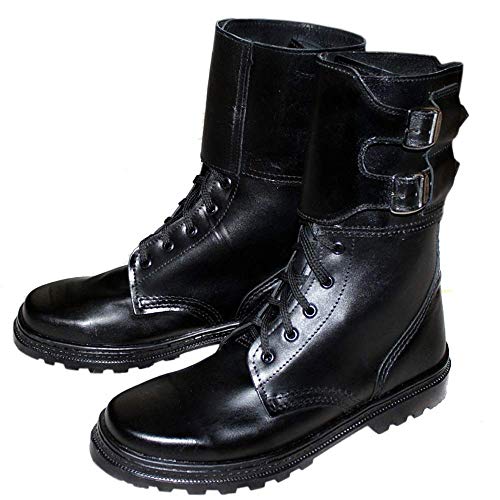
Bast Shoes (Lapti)
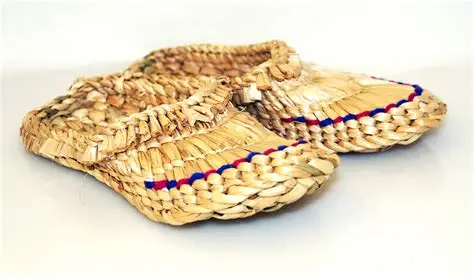
Lapti, woven from strips of linden or birch bark, are perhaps the most iconic image of old Russian peasant life. Lightweight and inexpensive, they could be woven quickly, making them accessible to the rural poor. Tied to the foot with simple cords, lapti were fragile and often replaced after only a few days of wear. Despite their fragility, they’ve become powerful cultural symbols—appearing in folk dances, proverbs, and decorative crafts. Today, lapti survive more as nostalgic emblems than practical footwear.
Russian Long Boots (Kirzachi & Sapogi)
High boots have long defined Russian style, equally practical and stylish. Kirzachi were mass-produced Soviet boots made from tough “kirza,” a canvas-based synthetic leather that balanced cost with durability—perfect for soldiers and workers. Sapogi, by contrast, were sleek leather pull-on boots, often polished and elegant, worn by both officers and civilians. Together they became icons of Russian identity: sturdy, commanding, and versatile. Their classic silhouette influenced equestrian fashion worldwide, while their enduring reputation for strength still resonates in military-inspired design.
